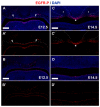Genetic Variants in Protein Tyrosine Phosphatase Non-Receptor Type 23 Are Responsible for Mesiodens Formation
- PMID: 36979085
- PMCID: PMC10045488
- DOI: 10.3390/biology12030393
Genetic Variants in Protein Tyrosine Phosphatase Non-Receptor Type 23 Are Responsible for Mesiodens Formation
Abstract
A mesiodens is a supernumerary tooth located in the midline of the premaxilla. To investigate the genetic cause of mesiodens, clinical and radiographic examination were performed on 23 family members of a two-generation Hmong family. Whole exome sequencing (WES) or Sanger sequencing were performed in 22 family members and two unrelated Thai patients with mesiodens. WES in the Hmong family revealed a missense mutation (c.1807G>A;p.Glu603Lys) in PTPN23 in seven affected members and six unaffected members. The mode of inheritance was autosomal dominance with incomplete penetrance (53.84%). Two additional mutations in PTPN23, c.2248C>G;p.Pro750Ala and c.3298C>T;p.Arg1100Cys were identified in two unrelated patients with mesiodens. PTPN23 is a regulator of endosomal trafficking functioning to move activated membrane receptors, such as EGFR, from the endosomal sorting complex towards the ESCRT-III complex for multivesicular body biogenesis, lysosomal degradation, and subsequent downregulation of receptor signaling. Immunohistochemical study and RNAscope on developing mouse embryos showed broad expression of PTPN23 in oral tissues, while immunofluorescence showed that EGFR was specifically concentrated in the midline epithelium. Importantly, PTPN23 mutant protein was shown to have reduced phosphatase activity. In conclusion, mesiodens were associated with genetic variants in PTPN23, suggesting that mesiodens may form due to defects in endosomal trafficking, leading to disrupted midline signaling.
Keywords: PTPN23; RNA expression; extra tooth; mesiodentes; mutation; phosphatase; protein expression; supernumerary tooth.
Conflict of interest statement
The authors declare no conflict of interest.
Figures












References
-
- Bolk L. Die Uberzahligen oberen incisivi des Menschen. Dtsch. Mscf. 2hk. 1917;35:185.
-
- Kositbowornchai S., Keinprasit C., Poomat N. Prevalence and distribution of dental anomalies in pretreatment orthodontic Thai patients. Khon Kaen Dent. J. 2010;13:92–100.
Grants and funding
LinkOut - more resources
Full Text Sources
Research Materials
Miscellaneous

